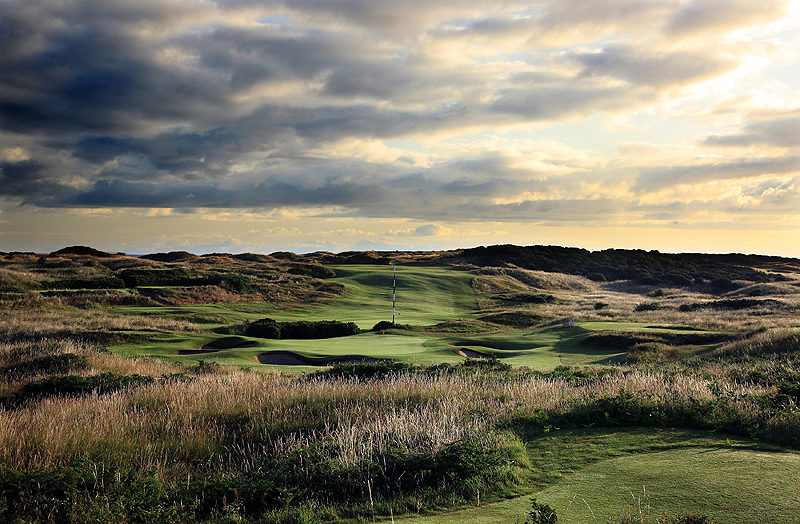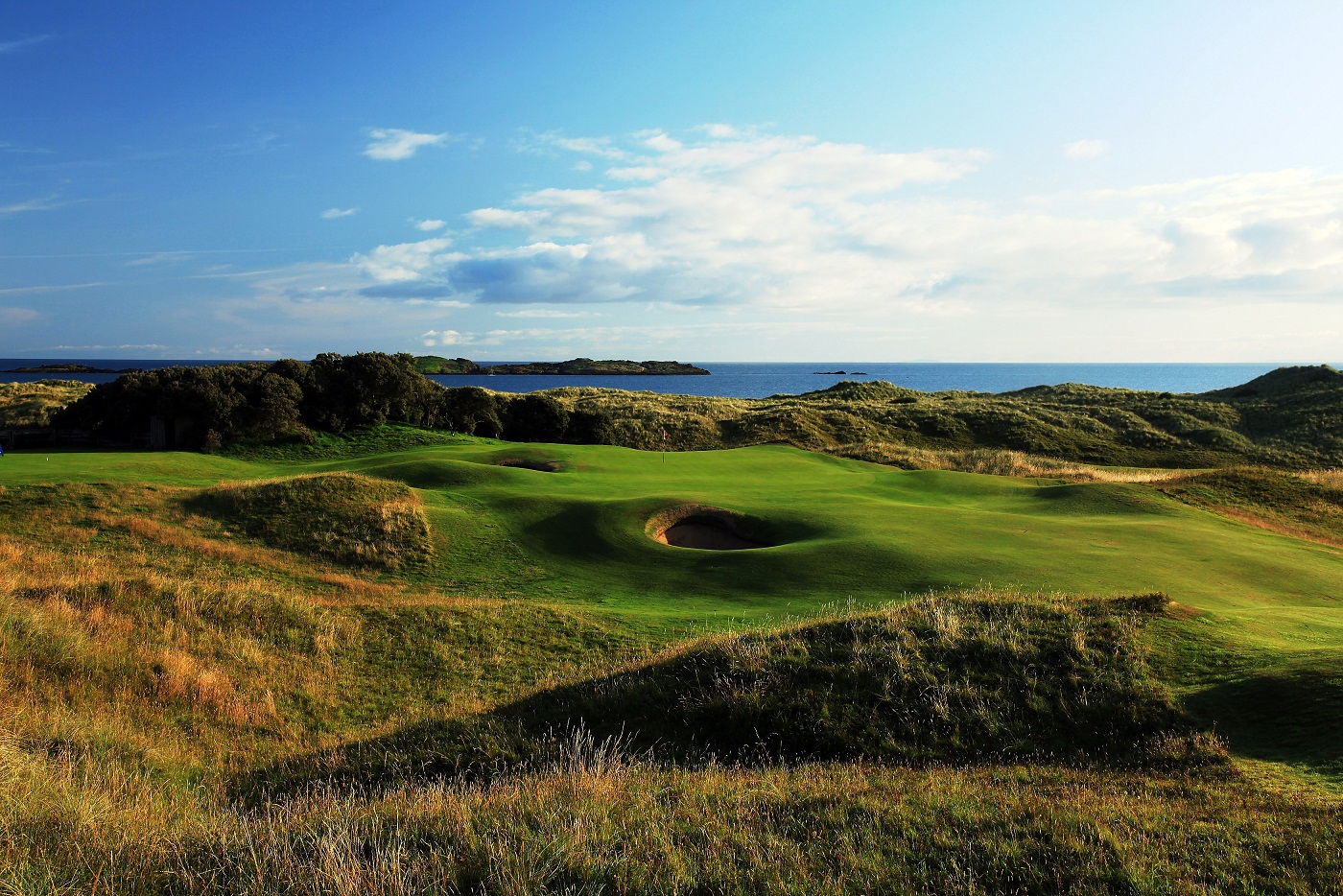Open Championship’s success and overwhelming praise for course by the world’s best golfers verify that it’s one of the world’s must-plays
PORTRUSH, County Antrim, Northern Ireland (July 23, 2019) – Just getting a chance to test your golf game at the famed Dunluce Links at Royal Portrush Golf Club – the host course last week for the 148th Open Championship – is a once-in-a-lifetime thrill. Now imagine playing the course under championship conditions, and with a gallery of more than 15,000 fans watching your every waggle, drive and tenuous putt.
Such was my “honor” in the summer of 2012 when I was among the fortunate few to participate in the pro-am portion of the Irish Open at Royal Portrush. It is a round that I can replay shot by shot in my mind even now, seven years removed from that cloudy, then sunny, then cloudy again, June afternoon.
Most golfers knew at least a little about Royal Portrush from the spotlight it has received over the years due to the success of three of its members, chaps named Rory McElroy, Graeme McDowell and Darren Clarke, major champions all. The 36-hole club has two links courses, Dunluce Links and Valley Links.
Dunluce Links remains the only course in Ireland to have hosted the Open Championship, in 1951, and now, gloriously, in 2019. Four days of sumptuous views during the international broadcast of the Open has whetted the golf appetite of true players around the world and brought the charms of the course to the attention of the general public.

My visit in 2012 coincided with the first time a European Tour event had been played in Northern Ireland and the first time since 1953 that the Irish Open was played in the country; it had previously taken place at Royal Portrush in 1947.
The overflow galleries all four days of the 2012 tournament (as well as the 15,000-plus for the pro-am) and the slam-bang job done by the club for the 2012 Irish Open assured Royal Portrush officials that the club would be on the short list to host a future Open Championship.
And once Portrush got the chance to show off, the course produced memories in spades.
Dunluce Links, a masterpiece of golf course architecture by the legendary Harry S. Colt, is ranked among the world’s greatest courses. Lined with treacherous out-of-bounds and thick rough, its holes end at some of the most challenging greens anywhere.
Colt used the natural contours and dunes to create a links that attracts the best players – pros and amateurs – around the world. The terrain, combined with the always unpredictable weather of a site along the North Atlantic, asks golfers for the best he or she has and an ability to rebound when the wheels fall off during a round, which they invariably will.
Located on a particularly beautiful stretch of the North Antrim Causeway Coast, Dunluce Links is constructed on an area of natural dunelands with limestone cliffs on its eastern side. Occupying a triangle of giant sand hills, the place offers distant western views of the hills of Donegal, with the Isle of Islay, the Southern Hebrides and, on a really clear day, the coast of Scotland up north.

Dunluce Links is just down the coast from the ruins of the 13th-century Dunluce Castle, for which the course is named. Royal Portrush Golf Club was founded in 1888 as “The County Club” and became “The Royal County Club” in 1892 under the patronage of the Duke of York. It received its “Royal” moniker in 1895 under the patronage of the Prince of Wales.
So many great holes
Colt designed Dunluce Links in 1929 and renovated it in 1947 in preparation for the 1951 Open. There have been championship tees built over the past few years to bring its length up to modern professional standards, with changes also made to a dozen holes over the decades.
In the runup to the Open Championship this year, Royal Portrush hired Open specialists Mackenzie & Ebert to oversee changes to the course in preparation for the 2019 Open, with involvement from the R&A.
The firm tweaked the course in spots, and the former 17th and 18th holes were replaced by two new holes, now carded as the seventh and eighth, built from land that had been part of the Valley course.
The first of the replacement holes is the 592-yard par 5 seventh, which plays down into the valley and rises gently up to a new green, hugging the enormous dunes to its right. “Big Nellie,” a huge bunker on the old 17th hole, was recreated to the right of this new hole.

Following that is the new eighth, a 434-yard par 4 occupying dramatic ground, with a severe drop to the left side of the fairway.
Dunluce Links now plays at an all-you-can-handle-and-more 7,344 yards, about 200 yards more than when I played the track in 2012.
The course occupies rugged links land and involves frequent changes of directions and elevations. The property consists of parallel sets of dune. Little fairway bunkering was needed as Colt utilized the curvature of the fairways between the dunes to put accuracy off the tee at a premium. From the second through the 18th, all the two- and three-shot holes bend one way or another.
Off the tee, mishit balls plunge into thick fairway-side grasses. Because the dunes sit mostly back from fairways and the terrain doesn’t appear too intimidating, the landing areas are smaller than one might think. Shots routinely bounce unpredictably off these mounded surfaces, and the deep rough is punishing.
There are so many holes that are so strong it’s tough to highlight just a few. The opener, a 416-yard par-4, epitomizes the Dunluce Links’ experience. Off a slightly raised tee, the tee ball must find the fairway between out-of-bounds on both sides and the approach must avoid a terrifyingly deep bunker at the green’s front-left.
The 479-yard par-4 fourth pushes uphill off the tee past OB right and thick rough left. There are several bunkers in the wavy fairway and the putting surface is partially hidden behind two small knolls.
Dunluce Links’ fifth is widely considered one of the most stunning par-4s in all of golf. Playing at a manageable 411 yards, the hole involves a drive that can be played over a series of mounds at the elbow of the dogleg-right. It has no bunkers, but the heaving green perches on the edge of a steep declivity above the beach (don’t be long, because that’s OB down there).
After putting out, stop and enjoy the stunning views towards Dunluce Castle and wave at the surfers braving the swells below.
No. 16 is called “Calamity Corner” and for good reason. Stretching 240 yards uphill and usually into the wind, this is one of the meanest par 3s anywhere. Between the tee and green lurk a yawning chasm and no bailout area. Mounds and hollows back and left of the green await the overaggressive. It’s hard to describe the feeling as you stand on this tee, knowing it will take a fantastic shot to hit the small target on the far side of the void.
Skilled golfers relish the chance to not only control the flight of the ball but also shape it either way off the tee, depending on the route of the hole and the day’s wind. Royal Portrush’s Dunluce Links offers such challenges in spades, and is one of the world’s truly great golf courses.
The Dunluce Links at Royal Portrush course will test every club in your bag, and each hole presents you with its own unique challenges. It remains the fairest links I have ever played. Sacrificing a little distance for accuracy, particularly if the wind blows, will give you every chance of playing to your handicap – that is, if you can keep your eyes off the majestic scenery.









